The New Woman
by Merchant's House Museum
Our thanks to guest blogger Esther Crain.
Esther Crain, a native New Yorker, is the author of 2016’s The Gilded Age in New York, 1870-1910 (Hachette) and the New-York Historical Society’s New York City in 3D in the Gilded Age (Black Dog & Leventhal) published in 2014. She is the founder and editor behind Ephemeral New York, a website that chronicles the city’s past, which was been featured in numerous publications, including the New York Times, New York Daily News, and New York Post.
Introducing the New Woman
They began appearing in the 1890s: young women, their hair pinned back or piled in loose waves under elaborate hats, striding confidently down Broadway and Fifth Avenue. Dispensing with the petticoats and heavy corsets that weighed their mothers down a generation earlier, these middle- and upper-class women dressed in crisp, high-collared shirtwaists and long tailored skirts—garments which scandalously rose several inches off the ground when they pedaled a bicycle on Riverside Drive or strolled along gusty 23rd Street.
This army of “new women,” as they were called, embraced the progressive thinking of the later Gilded Age. Not content to be confined to the sphere of the home, they took part in the social world of theaters and restaurants. Some attended new women’s colleges like Hunter and Barnard. Many pursued something of a career: in settlement houses, as typists, or in the arts. Perhaps they lived independently. “Bachelor girl” apartments were the latest fad reported by the press, which was endlessly fascinated by the New Woman’s comings and goings.
| . |
A City Captivated
“There had been much said in the newspapers concerning the New Woman and what kind of creature she was,” stated the Brooklyn Daily Eagle in March 1895. “The pictorial papers had ridiculed her, showing her standing at bars drinking on street corners smoking cigars. This ridicule, however, would not prevent the coming of the New Woman. She would occupy any and every place, which an intelligent human being could fill: the bar, the pulpit, the legislative hall, and will be found in every trade and profession.”
Older generations were shocked by her self-reliance and sense of purpose in the wider city. Her male counterparts took her autonomy in stride and enjoyed her propensity to play tennis and ride a bike. Cultural critics worried about her morals. Pioneering women’s rights activists largely cheered her on. “The finest achievement of the new woman has been personal liberty,” wrote writer and champion of women’s freedom Winnifred Harper Cooley in 1904.
.
What Did Gertrude Tredwell Think?
The New Woman must have been an alien creature to Gertrude Tredwell. Born in 1840, Gertrude was a product of a much smaller New York that barely extended past Union Square. At the time of her birth, the city’s population hovered at approximately 300,000; by 1860, about half a million more people inhabited New York, including immigrants largely from Ireland and Germany whose lives were vastly different than that of the Tredwell family.
In the pre-Civil War city, men of means like Gertrude’s merchant father, Seabury Tredwell, occupied the outside worlds of business and politics and could freely enjoy restaurants, saloons, and sports. Women like herself, her mother, and her sisters were supposed to be “the angel of the home,” raising children, managing her household, and influencing the moral development of her family.
Like the typical New Woman, Gertrude was born into comfortable financial circumstances. But the comparison ends there. The New Woman was determined to develop independence and live freely, her movement and safety enhanced by electric streetlights and the new whirring cable cars. Gertrude, on the other hand, didn’t leave the Tredwell home. She came into the world at 29 East Fourth Street, grew up in an enclave of wealth and refinement, and died in the same house, amid a much shabbier neighborhood, 93 years later.
The Fight for Equal Rights
Within the span of Gertrude Tredwell’s life, the equal rights era that led to the New Woman was ushered in. After the Civil War, Elizabeth Cady Stanton and Susan B. Anthony relaunched their fight for women’s rights, including the right to the vote. Working from an office on Newspaper Row, Stanton and Anthony published their weekly paper, Revolution. (“Men their rights, and nothing more; women their rights, and nothing less” was the motto.) They spoke out at lecture halls like Cooper Union at Cooper Square and Steinway Hall, on East 14th Street, both not far from the Tredwell home.
.
As the Gilded Age continued, individual women made strides. Dr. Elizabeth Blackwell, the nation’s first female doctor, opened a medical school for women. Despite the fact that she was legally barred from voting, Victoria Woodhull announced her quest to be the first woman president and ran on the new Equal Rights party ticket. Josephine Shaw Lowell founded the city’s Charity Organization Society. Nelly Bly and Alice Austen pioneered a type of journalism that called for social changes. Lillian Wald and Mary Kingsbury Simkhovitch founded settlement houses and sparked a wider movement to boost opportunities for women and children.
.
The Working Girl Makes Her Entrance
Rising at the same time as the Equal Rights movement and this new professional class of women was another Gilded Age female archetype: the working girl. With men off on the battlefields during the Civil War, women took their place. These young, often immigrant women toiled in factories, clerked in offices, cooked and cleaned in private homes, and acted as shop girls in the dry goods emporiums of Ladies Mile. After the end of the war, they continued to work. In 1869, one-fourth of all women in New York did paid labor, according to the New York Herald.
Upper class women tended to be indifferent to them. (“While yet your breakfast is progressing, and your toilet is unmade, comes forth through Chatham Street and the Bowery, a long procession of them by twos and threes to their daily labor,” wrote Fannie Fern in an 1868 essay aimed at the middle class.) Even so, the mass of working women changed the look of the city, joining men in streetcars on the way to work in the morning and back to their family home or boardinghouse when the day was done. They were the subject of plays and popular songs. No labor laws mandated that women and men in the same job get equal paychecks, so they were paid less. Harassment on the job was a problem, as was unscrupulous male bosses who wouldn’t pay up. To help, the Working Women’s Protective Union formed in 1863. Located on Bleecker Street, it was a few blocks—but worlds away—from the Tredwell home.
The Suffragist Hits the Streets
| . |
As women’s presence and power increased in New York, many coalesced behind one main goal: the right to vote. In the 1900s and 1910s, suffrage supporters rallied in Union Square and held many parades on Fifth Avenue that were catnip to the media, always obsessed with the New Woman and her sisters in arms. In 1912, about 10,000 parade marchers demanded the vote. In 1915, the number of marchers swelled to 40,000. In 1917, New York voters gave women the right to cast their ballots—three years before the 19th amendment was ratified.
Did Gertrude register to vote along with more than 414,760 women from New York State following the 1917 decision? No. But it’s hardly surprising. She would have been 77 years old by then, a member of the 19th century wealthy merchant class now living in the progressive 20th century, when the city’s population was closing in on 5 million. Her last surviving sister died in 1909, leaving Gertrude impoverished and alone.
Surely she was aware of the enormous changes in the status of women in her lifetime. She must have read newspaper accounts of Stanton and Anthony; certainly she came across the New Woman, striding along Broadway or socializing with friends. Gertrude likely watched shop girls head to factories and store counters from her window on East Fourth Street, now a rougher-edged neighborhood that was less residential and bent toward light manufacturing. What did she think of them and the new world women inhabited? If only the Merchant’s House walls could talk.
Tredwell family research contributed by William Herrlich.
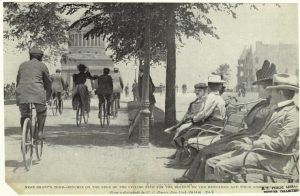
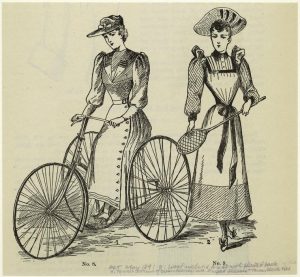
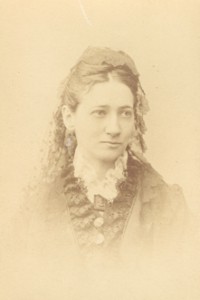
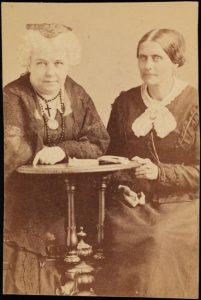
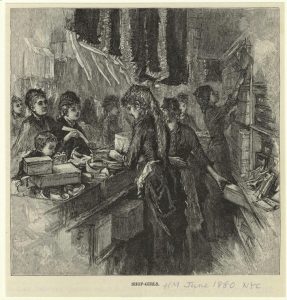
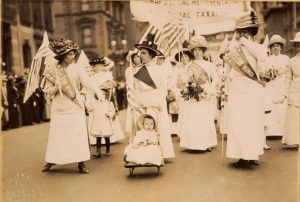



Thank you for this journey into our not so distant NYC and U.S. history, contextualized by the life of Ms. Treadwell. It reminds us that as far as we have come, and we can thank our New Woman predecessors for that – in our times we still have far to go for women’s rights and intersectional social justice.